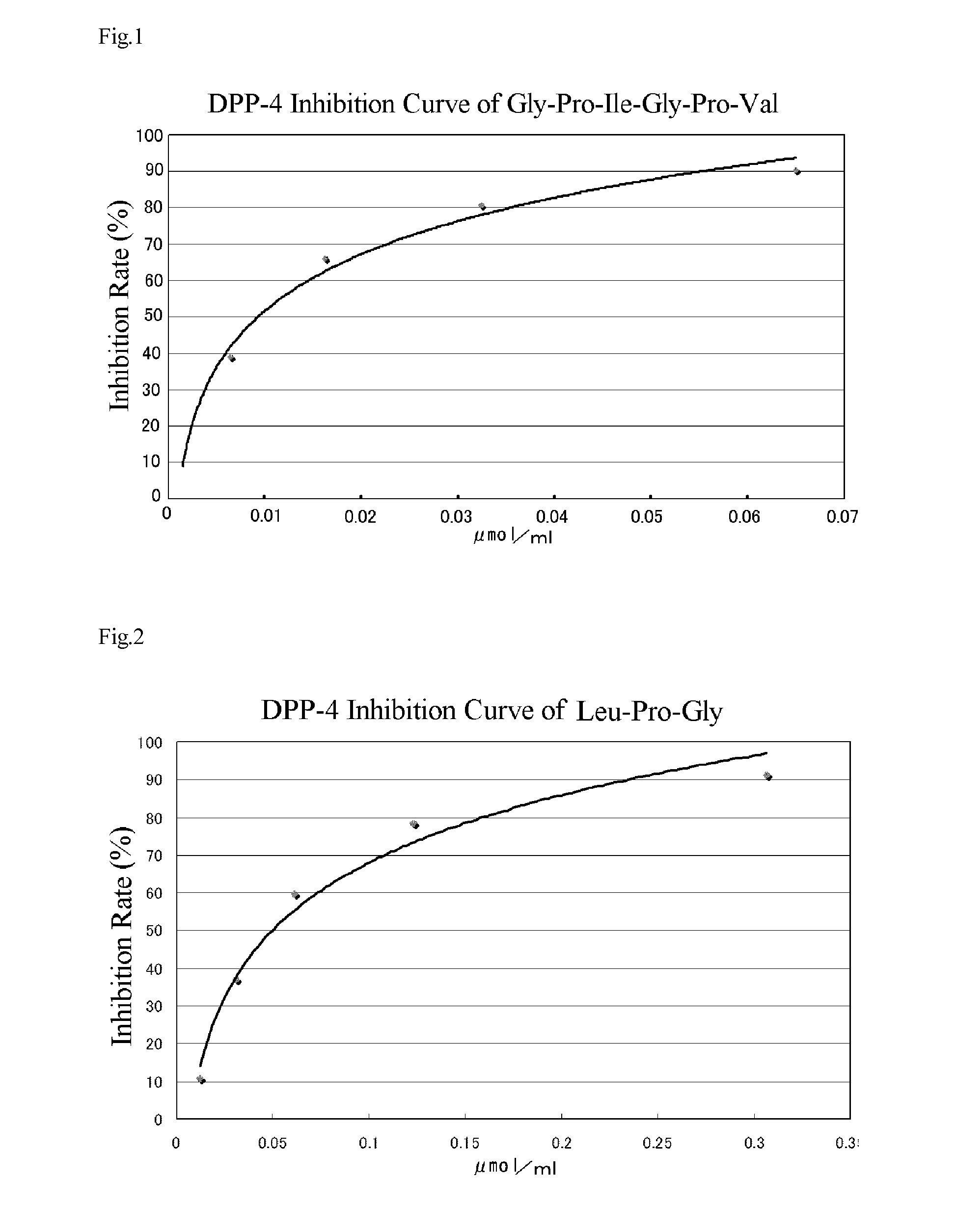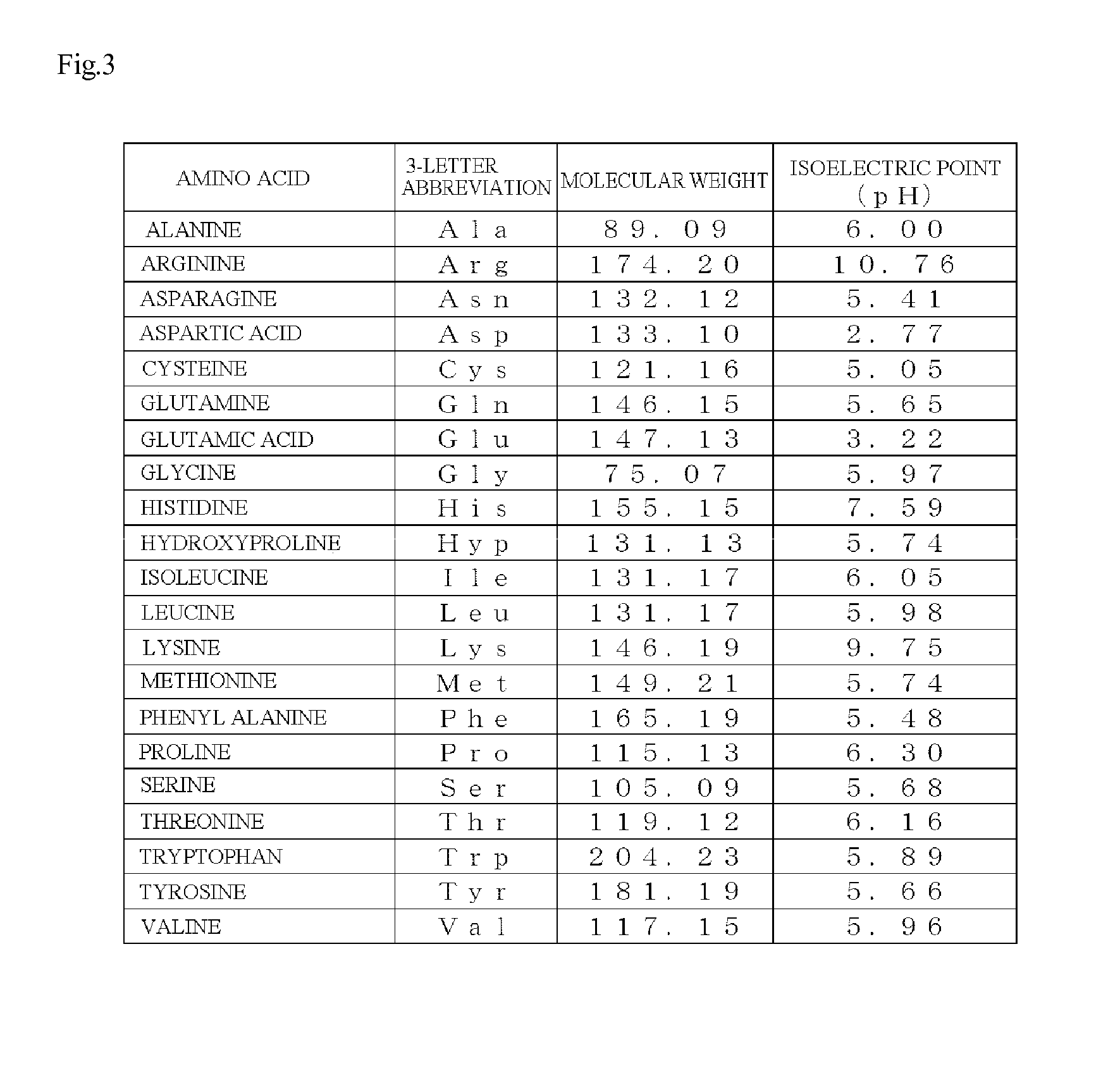Dpp-4 inhibitor
a dpp-4 inhibitor and inhibitor technology, applied in the direction of peptides, drug compositions, immunological disorders, etc., can solve the problems of impaired regulation of type 2 blood glucose level, and achieve excellent dpp-4 inhibitory activity and excellent safety
- Summary
- Abstract
- Description
- Claims
- Application Information
AI Technical Summary
Benefits of technology
Problems solved by technology
Method used
Image
Examples
example 1
[0082]Gly-Pro-Ala-Gly-Pro shown in Table 1 was synthesized by an Fmoc solid phase synthesis method using an automatic peptide synthesizer (433A) manufactured by Applied Biosystems.
[0083]The synthesis was carried out by a stepwise elongation method comprising supporting an amino acid corresponding to the C-terminal of oligopeptide to a resin and elongating one amino acid toward the N-terminal; and diisopropylcarbodiimide (DIC) and 1-hydroxybenzotriazole (HOBt) were used as condensing agents in a peptide coupling reaction which corresponds to an elongation reaction. Note that while the amino group of amino acid which was allowed to elongate toward the N terminal was protected by 9-fluorenylmethyloxycarbonyl (Fmoc), amino acids that compose the oligopeptide did not contain side chains with a reaction activity and thus the side chain was not in particular protected.
[0084]First, 0.5 g of Fmoc-Pro-Wang resin (0.5 to 0.8 mmol / g, manufactured by Bachem) obtained by protecting the N-terminal...
example 2 to example 9
[0088]Using Fmoc-Arg(Pbf)-Wang resin, Fmoc-Hyp-Wang resin, Fmoc-Ile-Wang resin, Fmoc-Val-Wang resin, Fmoc-Gln-Wang resin, and Fmoc-Pro-Wang resin as the C-terminal amino acid of an oligopeptide and using Fmoc-Gly-OH, Fmoc-Pro-OH, Fmoc-Leu-OH, and Fmoc-Ile-OH as an Fmoc protected amino acid, Gly-Pro-Ala-Gly-Pro-Arg (Example 2), Gly-Pro-Ala-Gly-Pro-Hyp (Example 3), Gly-Pro-Ala-Gly-Pro-Ile (Example 4), Gly-Pro-Leu-Gly-Pro-Val (Example 5), Gly-Pro-Ile-Gly-Pro-Val (Example 6), Gly-Pro-Val (Example 7), Gly-Pro-Gln (Example 8), and Gly-Pro-Ala-Gly (Example 9), all of which are shown in Table 1 were synthesized according to Example 1.
[0089]Note that because, unlike in Example 1, the synthesis of the peptide in Example 2 used Arg which contained two amino groups, Fmoc-Arg(Pbf)-Wang resin in which the guanidine group of the Arg side chain was protected with a Pbf group (2,2,4,6,7-pentamethyldihydrobenzofuran-5-sulfonyl group) was used and the Pbf group was removed by TFA at the end.
[0090]In t...
example 10 to example 15
[0092]Using amino acids whose amino group was protected by the Fmoc group, peptides in Examples 10 to 15, the peptides being shown in Table 1, were synthesized in accordance with Example 1 and the DPP-4 inhibition curve was prepared. The result is shown in Table 1. Note that because, unlike in Example 1, the synthesis of the peptide in Example 10 used Glu which contained two carboxyl groups, Fmoc-Glu(OBut)-Wang resin in which the carboxyl group of the Glu side chain was protected by a tertiary-butyl group (But group) was used and the But group was removed by TFA at the end.
[0093]Further, as for the peptide in Example 13, using Fmoc-Ser(But)-Wang resin as the C-terminal amino acid of oligopeptide, Gly-Ala-Ile-Gly-Pro-Ser was synthesized according to Example 1. Note that because, unlike in Example 1, serine which contained a hydroxyl group was used, Fmoc-Ser(But)-Wang resin in which the hydroxyl group of the Ser side chain was protected by a tertiary-butyl group (But group) was used a...
PUM
| Property | Measurement | Unit |
|---|---|---|
| concentration | aaaaa | aaaaa |
| pH | aaaaa | aaaaa |
| pH | aaaaa | aaaaa |
Abstract
Description
Claims
Application Information
 Login to View More
Login to View More - Generate Ideas
- Intellectual Property
- Life Sciences
- Materials
- Tech Scout
- Unparalleled Data Quality
- Higher Quality Content
- 60% Fewer Hallucinations
Browse by: Latest US Patents, China's latest patents, Technical Efficacy Thesaurus, Application Domain, Technology Topic, Popular Technical Reports.
© 2025 PatSnap. All rights reserved.Legal|Privacy policy|Modern Slavery Act Transparency Statement|Sitemap|About US| Contact US: help@patsnap.com


